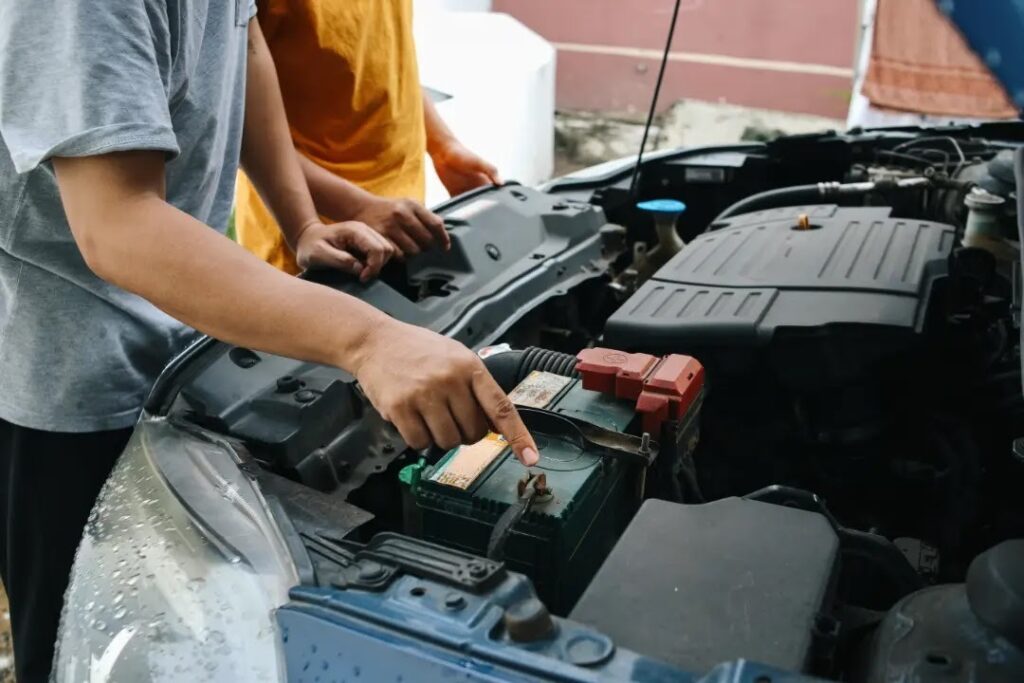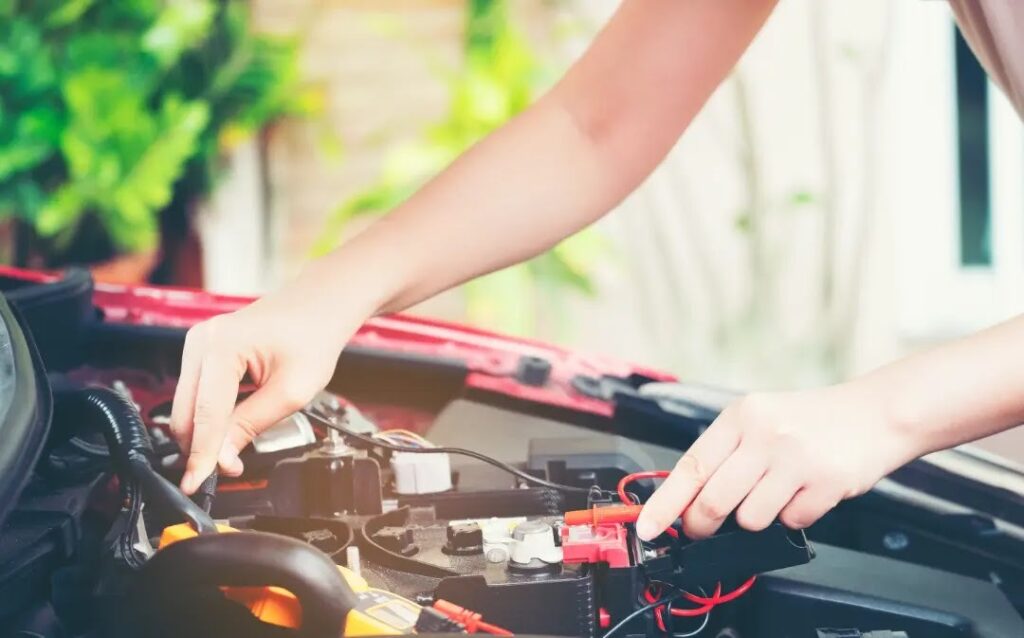Flat batteries are a leading cause of UK breakdowns, especially in winter. Keeping your car battery healthy means fewer unexpected stops, less hassle with call-outs, and more peace of mind for drivers across Kent.
This guide explains the benefits, warning signs, simple at-home checks, when to call a professional, and how Reds Recovery Services provides 24/7 jump-starts and support to keep you moving.
Here’s what we’ll cover:
- The benefits of battery care , longer life, lower costs, and better performance.
- Spotting the signs that your battery is struggling, like slow cranking, corroded terminals, or warning lights.
- Easy-to-follow steps for checking your battery at home and reducing unnecessary drain.
- When it’s time to call a professional to test, replace, or jump-start your battery in Kent.
- Local insights for Kent drivers, including how weather impacts your battery and how Reds Recovery Services supports your maintenance efforts.
Why Regular Car Battery Maintenance Matters
Regular car battery maintenance means simple checks that keep your electrical system running smoothly, help the battery last longer, and prevent unexpected failures.
By monitoring voltage, fluid levels, and terminals, you can catch small issues before they become big problems, saving time and money. Proactive care reduces roadside call-outs, improves cold starts, and maintains steady power for modern electronics.
The main benefits include:
- Longer battery life thanks to balanced charging and reduced corrosion.
- Lower costs by avoiding premature replacements and costly emergency call-outs.
- Greater reliability with consistent starts, whatever the weather.
- Improved performance, as stable voltage keeps sensors and infotainment systems working properly.
Regular upkeep prevents breakdowns and builds a simple check routine, making it easier to spot issues and know when to call for expert help.

How Battery Care Extends Battery Life
Battery maintenance protects internal chemistry and prevents a gradual decline. Cleaning terminal corrosion ensures a clear path for current, while checking and topping up fluid maintains the correct acid–water mix, preventing plate damage.
Regular voltage checks confirm the alternator is working properly, avoiding over- or undercharging, both of which accelerate wear.
These steps reduce sulphation and help maintain full capacity. With a steady charging routine and clean connections, your car battery should deliver three to five years of service.
How Maintenance Prevents Costly Breakdowns
Preventive care catches subtle issues before they cause failure. Monitoring voltage can reveal weakening cells, and clean terminals prevent resistance build-up that leads to no-start situations. Fixing minor issues during routine checks helps avoid expensive call-outs and towing fees.
Less downtime and fewer emergency jump-starts save money and provide peace of mind that your car is less likely to let you down on the move.
Why Battery Health Is Crucial for Car Performance
A well-maintained battery provides steady power to everything in your car, from the starter motor to your sat-nav and advanced safety features. Consistent power prevents issues like flickering lights, erratic displays, and electrical glitches that could affect safety.
A healthy battery also reduces strain on the alternator and charging system, extending the life of the electrical network.
Ultimately, battery performance is key to modern cars working as they should, showing the link between regular checks and a reliable drive every time you get behind the wheel.
What Are the Usual Signs Your Car Battery Is Failing?
When a car battery starts to fail, it usually gives clear warnings. Slow cranking, dim headlights, and dashboard warning lights often indicate declining capacity. You might also see corrosion on the terminals or a swollen case, pointing to internal damage or chemical issues.
Paying attention to these signals helps you avoid a sudden breakdown and either check the battery yourself or book a professional service before it fails.
Spotting a Slow Engine Crank and Dim Headlights
A slow engine crank means the starter sounds sluggish and the engine turns over with difficulty, often with clicking noises when you turn the key. Dim headlights at idle suggest voltage is too low, meaning the battery can’t meet high current demand. Both symptoms point to reduced reserves and higher internal resistance.
Recognising these signs early lets you test voltage at home or book a battery performance check before your next trip, preventing a no-start situation.
What Corroded Battery Terminals Reveal About Battery Health
That powdery white or blue-green deposit on your battery posts signals a chemical reaction with moisture. This corrosion increases resistance and hinders efficient charging. It disrupts current flow, causing voltage drops under load and accelerating plate degradation. This build-up means you should clean the terminals immediately and check the battery’s seals.
Cleaning corrosion and applying a protective coating restores contact and limits further damage, underscoring the value of regular terminal maintenance.
When to Worry About Battery Warning Lights and Frequent Jump-Starts
If a battery warning light appears on your dashboard, it may signal an alternator or battery issue, such as undercharging or an open circuit. If your car needs jump-starting more than once, it strongly indicates deeper cell failures or charging-system faults. Both situations increase the risk of being stranded and require professional diagnosis.
Book a full battery and alternator check as soon as a dashboard warning light appears to keep the car reliable and avoid a roadside recovery.
How Battery Age Affects Breakdown Risk
The older your battery gets, the more likely it is to fail. Most standard lead-acid batteries start to show signs of wear after about three years, with the risk of breakdown increasing significantly in years four and five.
As cells age, they lose their ability to hold a charge and become more sensitive to extreme temperatures. Knowing when your battery was installed allows you to plan for a replacement before it reaches the end of its reliable service life.
Proactively replacing an old battery removes a major breakdown risk and complements your regular maintenance routine.
How Can You Check Your Car Battery’s Health at Home?
Doing your own battery health checks helps you spot potential problems without paying for a service. A basic check uses a multimeter to measure resting voltage, checks fluid levels (if the battery has serviceable caps), and cleans terminals to ensure good connections.
These steps reveal charge status, electrolyte balance, and contact integrity, key factors in battery health.
By following a simple, regular routine, you can catch early signs and decide if you need a professional jump-start or a more in-depth diagnostic service.
Gear Needed for Effective Battery Health Checks
To accurately check your battery, you’ll need a few essential items:
- Digital Multimeter: For precise voltage and load readings.
- Battery Tester or handheld conductance meter: To assess cold cranking amps.
- Wire Brush and Terminal Cleaner: To remove corrosion and restore clean contacts.
- Safety Gloves and Eye Protection: To shield you from any acid splashes.
Using this equipment ensures reliable readings and prepares you for routine maintenance at home.
Visual Inspection and Cleaning of Battery Terminals
Start by putting on protective gear and disconnecting the negative cable first. Inspect the case for bulging or cracks, which can indicate internal damage.
Use a wire brush and a baking soda solution to neutralise acid deposits on posts and clamps, scrubbing to bare metal. Rinse thoroughly, dry completely, and apply a thin layer of dielectric grease to help prevent future corrosion.
Completing this cleaning improves contact and prepares the battery for accurate voltage testing during your next maintenance check.
When to Test Battery Voltage and Fluid Levels
Test resting voltage at least twice a year, ideally before winter and before summer. Test again once the battery reaches three years in service. A healthy 12-volt battery should read 12.4–12.7V with the engine off. For batteries with removable caps, check fluid every three months and top up with distilled water just to cover the plates, don’t overfill.
Sticking to a regular schedule keeps your battery ready for seasonal demands and resilient.
Best Ways to Avoid Battery Drain on Short Trips
Frequent short trips don’t give the alternator time to fully recharge the battery, gradually reducing capacity. To help prevent this:
- Try to combine errands into longer trips so the battery recharges fully.
- Turn off non-essential electronics while idling.
- Unplug accessories like dash cams when parked.
- Consider a smart trickle charger if you often drive less than 15 minutes a day.
These habits reduce parasitic drain, keeping the battery in better shape between formal checks.
When Is It Time to Seek Professional Battery Service or Replacement?
While DIY maintenance handles many routine tasks, complex issues, like internal cell failures or alternator problems, need expert attention. A professional can test conductance, check charging-system components, and pinpoint the causes of recurring discharge. Knowing when to call experts keeps your car safe and reliable without constant roadside interventions.
Getting professional help also provides immediate Jump-Start Service and full vehicle recovery if you break down in Kent, minimising disruption to your day.
Limits of DIY Battery Maintenance
At-home care can’t always detect hidden cell imbalances, faulty voltage regulators, or corrosion deep inside the battery case. DIY tools aren’t as precise as professional conductance testers, and some battery designs might hide fluid loss between cells.
Trying to tackle complex repairs yourself, like cleaning internal plates, could also void your warranty and even pose a personal safety risk.
Understanding these limitations helps you call trained technicians before minor faults become a complete power failure.
Signs It’s Time for a New Battery
You should consider a new battery if you notice:
- A conductance tester shows capacity below 60%.
- Persistent low voltage readings when the battery is under load.
- The battery casing looks swollen or has cracks.
- Fluid levels that don’t recover with a simple top-up.
- Needing frequent jump-starts even after cleaning terminals and checking the charging system.
When you see these signs, prompt replacement helps prevent no-start situations and repeated service calls.
How Reds Recovery Services Helps with Emergency Jump-Starts and Breakdown Recovery in Kent
Reds Recovery Services offers a 24/7 Jump-Start Service across Kent, with experienced technicians who get your vehicle started quickly and safely.
If a flat battery leaves you stranded, we’re equipped to handle full vehicle transport; if required, we’ll recover your car to a garage for charging system checks. This seamless combination of emergency assistance and expert diagnostics minimises disruption to your journey.
By combining professional jump-starts with regular maintenance, Kent drivers can be confident breakdowns will be resolved quickly.
How Does Regular Battery Maintenance Prevent Unexpected Breakdowns in Kent?
Consistent battery care reduces roadside failures in Kent by catching issues early. Seasonal voltage tests and terminal inspections combat temperature-related performance dips common in coastal and inland areas. Adding prompt replacement of older batteries helps prevent most breakdowns caused by electrical faults.
And if your preventive measures aren’t enough, you can rely on local recovery specialists to get you moving quickly, completing your prevention strategy.
Why Battery Maintenance Matters in Kent’s Weather
Kent has chilly winters and warm summers, and both extremes strain battery chemistry. Cold thickens the electrolyte, reducing efficiency, while heat accelerates internal corrosion and water loss. Regular checks before the seasons change balance electrolyte levels and stabilise voltage, preventing weather-related no-start episodes.
Addressing these climate-specific risks helps ensure uninterrupted driving year-round.
How Reds Recovery Services Provides 24/7 Jump-Start and Breakdown Assistance
With teams across Kent, we reach you quickly, day or night. Our technicians arrive with portable power units and conductance testers, offering immediate jump-starts. On arrival, we can jump-start or recover your vehicle, and a garage can perform battery and alternator tests. If a battery can’t be revived, we’ll arrange seamless recovery to a garage of your choice.
This complete support service complements routine maintenance by guaranteeing expert help whenever your preventive checks aren’t enough.
Most Common Battery-Related Breakdown Causes in Kent
| Symptom | Mechanism | Impact on Reliability |
|---|---|---|
| Corroded Terminals | Increased electrical resistance | Leads to slow starts and voltage drops |
| Low Electrolyte Levels | Water evaporating in hot weather | Exposes plates and causes premature wear |
| Weak Cells | Sulphation from incomplete charging | Results in low cranking power |
| Alternator Faults | Malfunctioning voltage regulation | Prevents full recharge and can overload the battery |
Battery faults are a leading cause of breakdowns, particularly in cold weather, underscoring the importance of regular inspections.
Benefits of Combining Maintenance with Professional Recovery Services for Kent Drivers
Pairing scheduled battery checks with on-call recovery support creates a robust safety net. Routine upkeep minimises the chance of getting stranded, while Reds Recovery Services’ 24/7 Jump-Start Service provides immediate help for unexpected failures. This dual approach balances self-reliance with expert intervention, offering cost savings and peace of mind.
What Are the Best Tips to Extend Car Battery Life and Avoid Breakdowns?
Maximising your battery’s lifespan involves a mix of regular checks, protective habits, and mindful usage.
Implementing a six-month maintenance plan, preventing terminal corrosion, managing electronic loads, and ensuring your battery is securely fitted are the cornerstones of effective care. These strategies work together to maintain a stable charge and minimise those unwelcome vehicle stoppages.

How Often to Schedule Battery Maintenance Checks
Car experts generally recommend having your battery’s health assessed every six months, ideally before the winter and summer seasons.
Once your battery reaches its third year, it’s wise to increase the frequency of inspections to every three months, as older cells become more prone to failure. Sticking to this schedule aligns your preventive care with known degradation patterns, helping to maximise its overall service life.
Effective Ways to Prevent Battery Terminal Corrosion
To keep your terminals free from build-up:
- Apply a thin layer of dielectric grease after each cleaning session.
- Use terminal protectors that help neutralise acid fumes.
- Regularly check and tighten clamp connections to prevent gaps where moisture can gather.
- Rinse and dry the posts thoroughly after using a baking soda solution.
These steps help maintain low-resistance connections and ensure consistent charging.
Ways to Minimise Battery Drain from Vehicle Electronics
Modern cars draw power even when they’re switched off to keep alarms, sensors, and infotainment systems running. To reduce this parasitic drain:
- Turn off interior lights and unplug dash cams when leaving the car overnight.
- Limit charging of Bluetooth and USB devices when the engine isn’t running.
- Use “eco” or “sleep” modes on any aftermarket accessories where available.
These habits help conserve your battery’s charge and maintain its full capacity between drives.
Role of Proper Battery Installation and Secure Mounting in Longevity
A securely fitted battery can withstand vibrations, which can otherwise fracture internal plates and speed up sulphation. Making sure it’s installed correctly with the manufacturer’s recommended clamps prevents unnecessary stress on the casing and terminals. Proper installation also aids effective cooling, preventing heat-related fluid loss and internal corrosion.
By ensuring a secure fit and precise connections, you maintain battery integrity and consistent performance over time.
FAQs on Car Battery Maintenance and Breakdown Prevention
Drivers want clear advice on balancing DIY care with knowing when to call a professional. The sections below offer concise answers on check frequency, early warning signs, and what to do when a battery fails.
How Often Should a Car Battery Be Checked?
Most car experts suggest checking your battery at least twice a year, once before winter and once before summer, to prepare for temperature extremes. After three years, increase checks to every three months, as older batteries lose capacity faster. This schedule aligns maintenance with known wear patterns and helps prevent unexpected no-start incidents.
What Are the Early Signs of a Dead or Failing Battery?
Key symptoms to watch out for include:
- A sluggish engine crank, possibly with clicking sounds.
- Headlights that appear dim or flicker at idle.
- Corrosion or a white powdery substance on the terminal posts.
- A battery warning light illuminated on your dashboard.
Recognising these signs prompts timely testing or professional service before a breakdown occurs.
Can Regular Battery Maintenance Really Prevent Breakdowns?
Absolutely. Consistent maintenance tackles root causes, corrosion, low fluid, and cell imbalance, before they escalate. Visual inspections, terminal cleaning, and voltage tests identify problems early, reducing the risk of discharge and roadside emergencies. Regular checks significantly reduce battery-related call-outs.
How Can You Safely Perform Battery Maintenance at Home?
Always wear protective gloves and eye protection when inspecting or cleaning a battery. Disconnect the negative cable first, then the positive, to avoid short circuits.
Use a baking soda solution and a non-metallic brush to remove corrosion, rinse thoroughly, and dry completely before reconnecting. Follow the manufacturer’s guidelines for checking fluid levels and topping up to maintain safe operating conditions.
Following these best practices ensures your safety and sustained battery performance, reducing breakdown risk and complementing expert support when needed.
